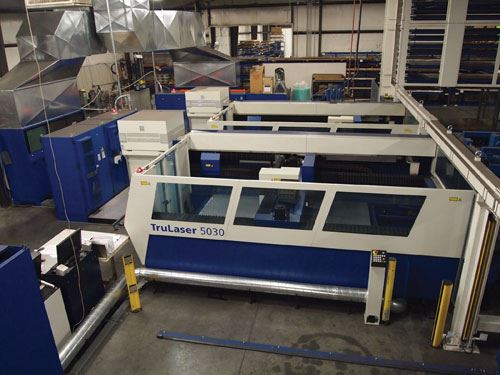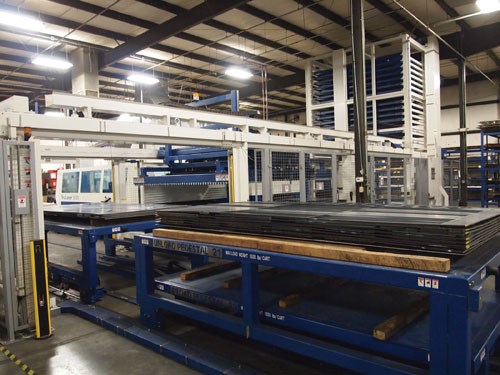Although “beam on” might sound like a phrase from a science fiction movie, it likely conjures a notion more akin to science fact in the mind of anyone familiar with the kinds of lasers used in real-world fabricating operations. For them, “beam-on time” means uptime, and maximizing it requires integrating the right laser-cutting machines with the right auxiliary equipment for the right kinds of applications.
According to management at TMCO, efforts to do just that have been a resounding success at this Lincoln, Nebraska-based job shop. There, a new laser cell consisting entirely of equipment from Trumpf (Farmington, Connecticut) has significantly boosted beam-on time, primarily by enabling additional lights-out operation. Setup times have decreased, as have labor costs. Capacity has increased, and production planning is more efficient. As a result, the company is better able to meet shortening turnaround requirements, take on more work and respond to diverse, ever-changing customer needs.
Driving Growth
As director of operations for the National Mfg. and Metal Art Divisions of TMCO, Dan Moore experiences the benefits of the cell both as a customer and as a member of the company’s management team. The cell, which the metal fabricating department uses for the bulk of its work, was installed in mid 2010. The goal was to be able to provide customers with shorter lead times and competitive pricing, Mr. Moore says. “In an economy that demands better inventory control, we need to help create solutions,” he explains. “The laser cell allows faster turnaround, and the ability to operate lights-out helps make it economically feasible. It’s a win-win situation for everyone involved.”
That strategy—making a conscious effort to drive growth, even in uncertain times—accounts for much of TMCO’s success since its founding in 1974, Mr. Moore says. In fact, the company has quadrupled in size since then, having added assembly, welding, painting, powder coating and sheet and tube fabricating to its original CNC machining services. Its 175 employees operate out of a four-building campus with approximately 200,000 square feet of manufacturing space. In addition to concept-to-completion metal manufacturing, these facilities house divisions that produce an in-house-designed line of lawn sprinklers, build food industry analysis equipment, and turn scrap metal into sculptures and other works of art.
Seeking Capacity
As laser supervisor of the metal fabricating division, Ed Rhoades works with the new cell on a daily basis. Prior to installation, he explains, his department relied primarily on two Trumpf laser cutters: a 6,000-watt TruLaser 5030 and a 4,000-watt TruLaser 3030. Only one of those machines, the 5030, was equipped with any sort of automation, a Trumpf LiftMaster loading/unloading system.
That machine typically ran unattended every night and during the weekend. Before leaving, operators prepared the machine and loader for lights-out shifts by stacking material for pending jobs. That approach was limited, however. Jobs with common materials often had to be scheduled in succession, regardless of their priority. This limited flexibility, a critical concern because much of the shop’s work consists of low-volume batches. “We could only stack so much, and we could only stack certain materials on top of each other,” Mr. Rhoades recalls. Additionally, the single, automated machine simply couldn’t keep up with increasing customer demand for faster deliveries.
Beam On
In the Trumpf cell, Mr. Rhoades and the rest of the management team “saw an opportunity to create a well-balanced laser layout that would not only meet our needs today, but also facilitate any future equipment addition,” he says. The system would consist of a new 5,000-watt Tru-Laser 5030 laser cutter integrated with the shop’s existing, 6,000-watt 5030. Both machines would be serviced by a new loading/unloading system, a LiftMaster Linear unit with a parts-sorting option. Additional equipment would include a TruStore Series 3000 storage tower, three mobile unloading carts and a cell controller. The old LiftMaster unit, which previously serviced the shop’s existing 5030, would be moved to the TruLaser 3030 to enable that machine to run unattended as well.
Implementing the cell and installing the loading/unloading system on the 3030 took the shop from one automated machine to three, more than doubling lights-out capacity, Mr. Rhoades says. As a result, the company can produce more parts faster with less operator intervention. Whereas the previous system required three technicians to tend to the lasers—two during the first shift and one during the second—the new arrangement has reduced setup and material handling tasks to the point where the shop now needs only two, both of whom work during a single, manned shift. The cell’s footprint is also compact enough to facilitate the addition of more equipment later.
Adaptive Automation
While additional, untended beam-on time is useful in and of itself, many of the efficiency benefits of the new machine arrangement stem from being able to use this time flexibly, Mr. Rhoades says. “The equipment is robust and adaptive to what we need,” he says. “We can stock the cell with multiple material types and set up multiple runs.”
Much of that flexibility stems from the cell’s auxiliary equipment, the LiftMaster Linear loading/unloading system and TruStore material storage tower. With 15 shelves that can each accommodate 6,600 pounds of material, the tower can house large quantities of various types of raw sheet. Compared with the previous, manual material-handling system, this enables the shop to schedule much longer lights-out shifts that involve a greater diversity of work. By extension, the shop can plan production much further ahead than it could before. In fact, what Mr. Rhoades refers to as “production packages”—essentially, detailed instructions for each job that tell the cell controller how and where to load and unload, which material to use and so on—are often stacked hundreds deep awaiting scheduling.
To retrieve raw sheet, a shelf-servicing elevator unit moves up and down the tower, retrieving pallets of material according to instructions from the cell controller. It stages that material at one of two separate loading stations, one on top of the other, for pickup by the LiftMaster. This enables the company to have two different types of sheet material ready for loading to either machine at a moment’s notice. The shelf-servicing unit can rearrange the material in the two staging areas as-needed according to production demand, eliminating the need to return all the way back up into the tower until production calls for a third material type, Mr. Rhoades says.
For its part, the LiftMaster features an automatic sorting option that significantly reduces material handling for finished parts, Mr. Rhoades says. This unit moves along a horizontal axis to connect the two machines, the TruStore tower and the three unloading carts. For handling raw sheet and finished parts, it is equipped with a rake-like apparatus as well as suction cups, the latter of which are mounted on a carriage that retracts into the unit when not in use. In a typical unloading scenario, the suction cups pick up finished parts that have been separated from the scrap skeleton. Usually, the suction cups are employed for parts that are large or otherwise cumbersome to handle, and/or those that require delicate handling to avoid surface scratches and other imperfections, he explains. The suction cups then retract back up into the unit to enable the rake to pick up the scrap skeleton and any remaining loose parts. Finally, the system moves along the horizontal axis and neatly stacks all of this material in its separate, designated locations in one, fluid motion.
Auxiliary Equipment Is Just That
Even the most sophisticated automation system would be for naught if the object of that automation—the machine doing the actual processing—were ineffective. And TMCO’s varied production demands flexibility from not only storage and loading systems, but also the machines they service. The two TruLaser 5030s in the cell and the standalone TruLaser 3030 are charged with processing materials ranging from 0.005-inch shim stock in aluminum to 0.375-inch stainless steel, and sometimes even carbon steel, without operator intervention. Volumes and sizes vary, and the machines are also used for in-house projects such as building fixtures and laminated punch and die sets for custom forming jobs.
In this environment, the Trumpf machines’ ability to cut different materials and thicknesses without changing cutting heads helps maximize beam-on time, Mr. Rhoades says. This is possible via a custom system that uses water pressure to adjust the curvature of the mirrors that direct the beam. As the pressure of the water behind each mirror increases, its curvature becomes more convex; as the water pressure decreases, its curvature becomes more concave. The beam’s focal length and diameter change in small increments. “Whether cutting thick or thin material, stainless or aluminum, the lasers change over very quickly with consistently high cutting quality,” he notes.
Other machine attributes reduce production times more directly, Mr. Rhoades says. For instance, he notes that the machines’ piercing technology makes “short work” of even the thickest material. Similarly, the use of linear axes provides high transit speed from point to point. Such features explain why TMCO has returned repeatedly to Trumpf for its laser cutting needs, Mr. Moore concludes.









.jpg;maxWidth=300;quality=90)






.png;maxWidth=300;quality=90)















